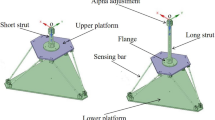Abstract
Effects of the interaction between components have been studied and modeled for a five-component internal strain gauge balance which is extensively used for force and moment measurement in wind tunnels. The calibration matrix has been constructed using a central composite design, designed experiment with additional axial points on the factorial faces and dead-weight loading scheme was developed for simultaneous application of moments and forces. A run efficient test matrix along with star points and replications was included to the scenario. The calibration results were then used to construct a response surface model (RSM), to relate the output voltages and the loads applied to the components. The RSM model obtained for each component revealed mutual couplings between them. Such interactions play a vital role in the measurement accuracy of balances. The interactions between some components may be insignificant and just increase the random errors in a regression model. In this paper, using proper statistical metrics, the significant interactions have been identified and retained in the RSM model while the others were removed. The models obtained by RSM in which the interaction terms have been intellectually selected and considered based on their degree of interaction were then compared with the conventional second-order regression model including all possible interaction terms. The comparisons show a smaller lack of fit error and a better agreement with actual loadings for the present partial interaction method, than that in which all interactions have been taken into account.











Similar content being viewed by others
Abbreviations
- x :
-
Longitudinal axis passing through the axis of symmetry
- y :
-
Lateral axis normal pointing to the right when looking from the rear
- Z :
-
Normal axis pointing upward when looking from the rear
- N :
-
Normal force (in z direction) (N)
- Y :
-
Side force (in y direction) (N)
- P :
-
Pitching moment (about y axis) (N m)
- R :
-
Rolling moment (about x axis) (N m)
- Y :
-
Yawing moment (about z axis) (N m)
- MX:
-
The rolling moment strain gauge
- MZ1:
-
Strain gauge 1 in z plane
- MZ2:
-
Strain gauge 2 in z plane
- MY1:
-
Strain gauge 1 in y plane
- MY2:
-
Strain gauge 2 in y plane
References
Rhew R, Parker P (2017) Rigorous design and analysis of wind tunnel balance calibration load schedules. In: 33rd AIAA aerodynamic measurement technology and ground testing conference, Denver, Colorado, AIAA 2017-4427
Wang YP, Yunfeng L, Changtong L, Zonglin J (2016) Force measurement using strain-gauge balance in a shock tunnel with long test duration. Rev Sci Instrum 87:055108
Fernandes JT (2018) Design of a wind tunnel force balance. MSc thesis, The Technical University of Lisbon
Giunta A, Wojtkiewicz S, Eldred M (2003) Overview of modern design of experiments methods for computational simulations. In: 41st AIAA aerospace ssciences meeting and exhibit, Reno, Nevada, AIAA Paper 2003-0649
Box G, Behnken D (1960) Some new three level designs for the study of quantitative variables. Technometrics 2:455–475
Deloach R, Ulbrich N (2007) A comparison of two balance calibration model building methods. In: 45st AIAA aerospace sciences meeting and exhibit, Reno, Nevada, AIAA 2007-147
Parker PA, Morton M, Draper N, Line W (2001) A single-vector force calibration method featuring the modern design of experiments. In: 39th Aerospace sciences meeting and exhibit, Reno, Nevada, AIAA Paper 2001-0170
Deloach R (2006) Impact of loading selection and sequencing on a force balance calibration (invited). In: 25th AIAA Aerodynamic Measurement Technology And Ground Testing Conference, Nevada, AIAA 2006-3436
Simpson J (2005) Calibrating large capacity aerodynamic force balances using response surface methods. AIAA 2005-7601
Nouri NM, Mostafapour K (2016) Development and evaluation of calibration procedure for a force-moment balance using design of experiments. Latin Am J Solids Struct 13:1
Montgomery DC (2013) Design and analysis of experiments, 8th edn. Wiley, New York
Stephens MA (1974) EDF statistics for goodness of fit and some comparisons. J Am Stat Assoc 69(347):730–737
Kenett RS, Zacks S, Amberitu D (2014) Modern industrial statistics, 2nd edn. Wiley, New York
Schmidt E (1985) Standard dynamics model experiments with the DFVLR/AVA transonic derivative balance. AGARD CP-386
Jansson T, Torngren L (1985) New dynamic testing techniques and related results at FFA. AGARD CP-386
Soltani MR, Davari AR (2004) Identification of a new similarity parameter to investigate the unsteady aerodynamic behavior of an aircraft in pitching motion. Aeronaut J 108:1086
Author information
Authors and Affiliations
Corresponding author
Additional information
Technical Editor: André Cavalieri.
Publisher's Note
Springer Nature remains neutral with regard to jurisdictional claims in published maps and institutional affiliations.
Rights and permissions
About this article
Cite this article
Norouzi, Z., Davari, A.R. & Haghiri, A.A. A new approach based on response surface methodology to take into account the effects of interaction between components in a force measurement balance. J Braz. Soc. Mech. Sci. Eng. 42, 382 (2020). https://doi.org/10.1007/s40430-020-02467-3
Received:
Accepted:
Published:
DOI: https://doi.org/10.1007/s40430-020-02467-3




